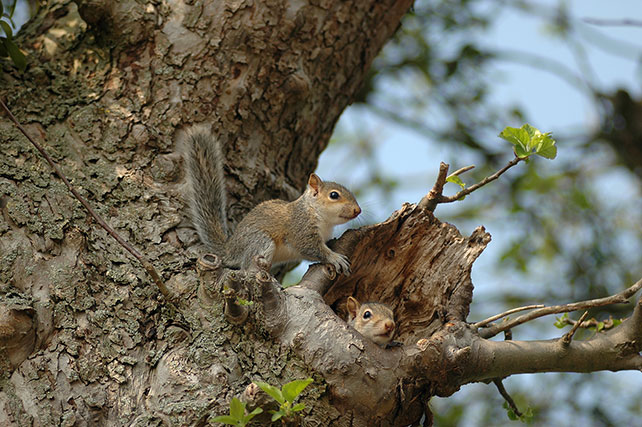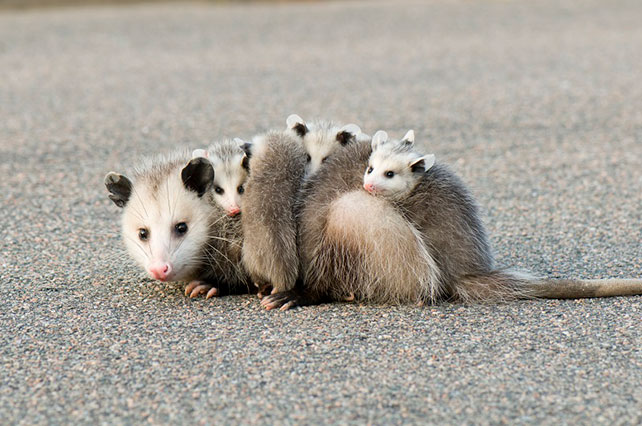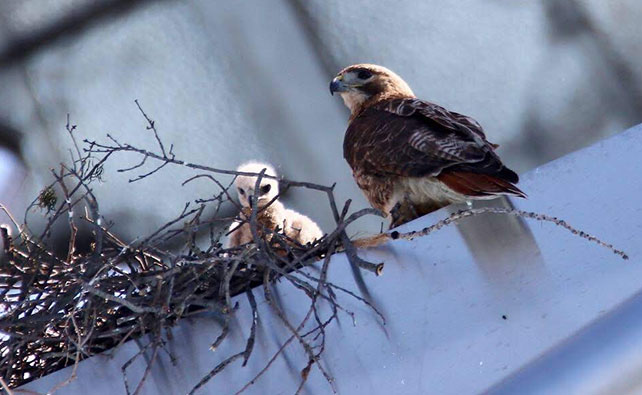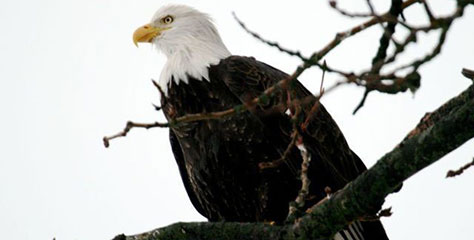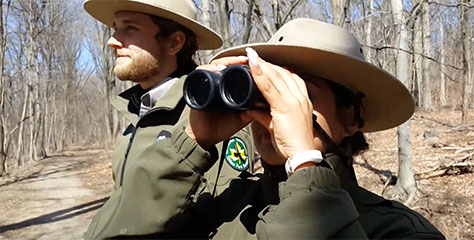Baby Animals in New York City Parks During Spring
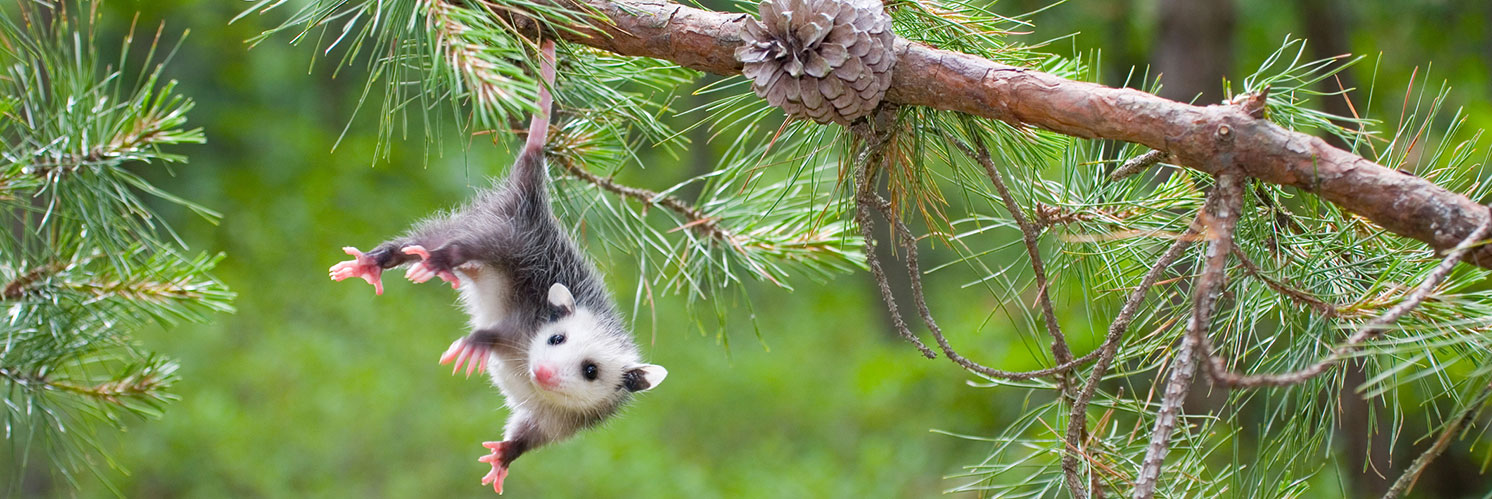
Spring has sprung! The sun is shining, flowers are blooming, and many wildlife species are welcoming their young into the world.
As baby animals begin to venture out this spring, you’re more likely to spot them exploring our parks. For their safety and yours, please always appreciate them from a safe distance. And if you care, leave them there! Parents are usually close by and can provide the best care for their young.
Let’s meet some of the new faces this spring:
Raccoons
Raccoons usually mate in late winter or early spring and give birth to 2-5 babies per litter about two months after mating. The babies are called “kits”. They leave their dens with their mothers about 8-12 weeks after birth and usually venture off to find their own territory the following spring. Some will strike out on their own as early as autumn!
Traditionally, raccoons make their dens in tree cavities, hollow logs, rock crevices, or burrows abandoned by other mammals. They will also make use of storm sewers and small spaces under or within buildings. Look for them in parks such as Forest Park in Queens or Riverside Park in Manhattan.
Eastern Gray Squirrels
Squirrels can give birth 1-2 times per year in litters of 1-5 babies. Squirrels conceived during the winter mating season can be born in early spring. Squirrel babies are small, pink, and hairless, and depend on their mother’s milk to grow. They will leave the nest after 42-49 days (a little over a month). Keen wildlife watchers can identify younger squirrels by their slightly smaller size and shorter hair on their bodies and tail.
If a healthy baby falls out of the nest, the mother will go down and retrieve them, so don’t worry if you see one!
Look for squirrels nesting in mature trees within your neighborhood or local park. They will create nests, called dreys, out of leaves or use small tree cavities.
Opossums
Opossums are North America’s only marsupial, meaning mothers have a pouch to carry and nurse their young, much like Australia’s famous marsupials — kangaroos and koalas! Opossums have two breeding seasons per year: January - late March and mid-May - July. After birth, the babies (called “joeys”) climb into their mother’s pouch and stay attached to the nipple for 50-70 days. After 70 days, they will leave the pouch but will still cling to her fur for several weeks.
Opossums can be found in a variety of habitats, from larger parks like Marine Park in Brooklyn to smaller landscaped parks such as Morningside Park in Manhattan. They will den in tree hollows, logs, sewers, buildings, or dens abandoned by other animals.
Coyotes
Coyote mating season peaks in late winter, from January to March, and pups begin to arrive in April and May. They are born blind with short fur but after 5-9 weeks, they begin to emerge from their den. There are more public sightings during this period, as pups start to spend more time outside of the den.
New pups will be raised by their parents and other coyotes in their family group. After the pups are weaned, both adult males and females will hunt and bring back food for the pups.
Coyotes can be found across the city in urban neighborhoods, forested and natural areas, and larger parks such as Pelham Bay Park in the Bronx.
Red-Tailed Hawks
The mating season for red-tailed hawks begins in early March and they sometimes showcase aerial courtship displays. Following courtship and mating, female hawks will lay one to five eggs in early April. Both males and females take turns incubating the eggs for about one month.
After the baby hawks, (called “eyases”) hatch, their parents will care for them for up to six weeks, until they are ready to fly.
Juvenile hawks are distinguished from mature adults by the color of their tail feathers and eyes. The irises of their eyes begin as a light brown or gold and will darken with age. The tail feathers of younger hawks are brown with black horizontal stripes. As they reach maturity, these feathers will be replaced with their namesake reddish-brown feathers.
Red-tailed hawks traditionally nest in mature deciduous or coniferous trees. They are adapting to also use human-made structures to also support their nests and can be found in all five boroughs.
Pigeons
As iconic a symbol of New York City as the pigeon is, most New Yorkers have likely never seen a baby pigeon. That’s because pigeons build their nests in enclosed spaces, like building awnings, and the babies (called “squabs” or “squeakers”) don’t emerge until they are fully feathered and look like adults.
Pigeons often mate for life and males and females share parental duties, including incubating and feeding. On average, eggs hatch after 19 days of incubation. Very young squabs are fed a milk-like substance that can come from either parent’s crop (part of the throat).
Pigeons have adapted well to live alongside humans and can be found nesting citywide in and out of parks.
White-tailed Deer
Baby deer, called “fawns”, are able to stand at birth, but are not able to keep up with their mothers until they are about one month old. A mother will leave her fawn(s) unattended for hours while she forages for food. So, if you see one alone, mom is likely nearby or on her way back.
As an added protection, fawns are born with spots to help with camouflage, especially while their mother is foraging. They will not move at all so as not to attract predators. As they get older, they lose their spots!
White-tailed deer can be found near food and water in forested and grassland parks, and even on the edges of those areas. Observe them from a distance in parks such as Pelham Bay Park in the Bronx or Conference House Park in Staten Island.
What to Do if You See Baby Wildlife
If you care, leave them there! Parents are usually close-by and can provide the best care for their young. By keeping your distance, you are giving the animal parents the space to care for their young themselves.
Learning to Fly
Don’t be alarmed if you find a baby bird on the ground. Parents will continue to feed and care for healthy young even on the ground. During summer and early fall, you may even see juvenile hawks and falcons on the ground or on low perches. They are still learning how to fly and, like any toddler, they tire easily and will have to learn from their mistakes. Observe all baby birds from a distance and enjoy watching them as they get care from their parents and learn how to fly.
Fawning Over Deer (From Afar!)
No matter how cute they may look, if you see a baby deer, please leave it be. Healthy fawns are often left alone for hours at a time and their mothers will return to care for them after foraging. Please appreciate them from a distance and don't offer them food.
Reporting Injured Animals
If you see a baby animal in a park and believe it may be injured, please report it to our Urban Park Rangers by calling 311. They can determine whether it is best to bring the animal to a medical care center or leave it alone for a parent to retrieve it.
Explore Wildlife in New York City
New York City is home to an amazing abundance of wildlife from birds to eels and coyotes and deer. Learn more about their life here in the big city and how we help them thrive.
Wildlife in New York City
Discover which wildlife live in our city and find fun wildlife activities to learn more!
Wildlife Calendar
Use our wildlife calendar to learn about wildlife behavior by the month and where they thrive in our city.
Wildlife Programs
Join our Urban Park Rangers and friends as we head into the park to see and learn about wildlife.


